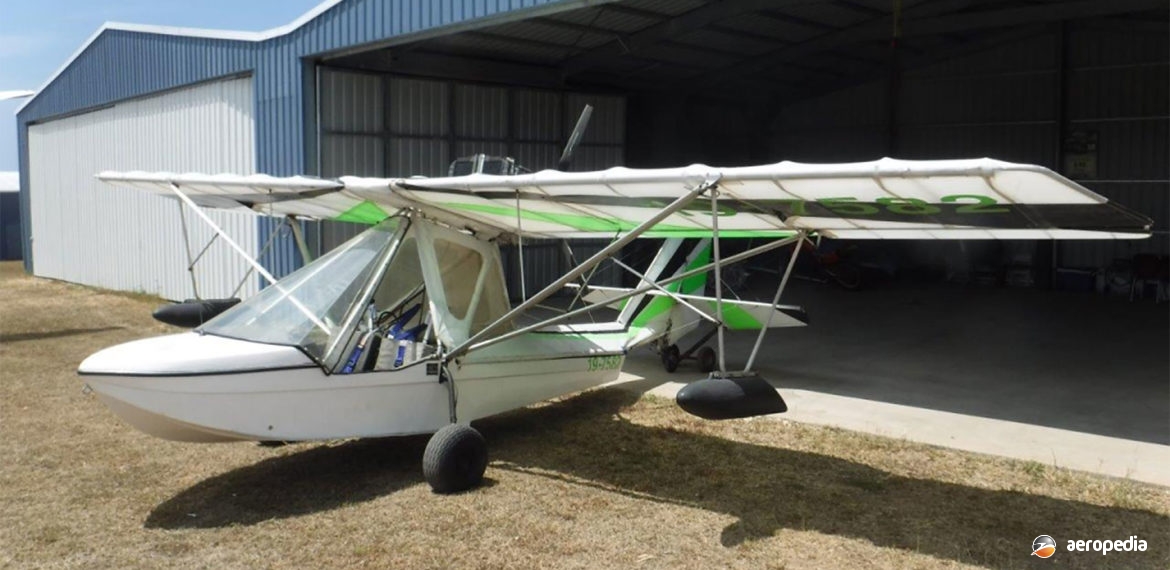Photograph:
Advanced Aeromarine Buccaneer B-IIB 19-7582 ( c/n B2B-K169) in the Whitsundays, QLD (Author’s collection)
Country of origin:
United States of America
Description:
Single or two-seat light sport amphibian
Power Plant:
(Buccaneer II)
One 48 kw (65 hp) Rotax 582UL-V two-cylinder, horizontally-opposed, liquid-cooled engine
Specifications:
- Wingspan: 8.99 m (29 ft 5 in)
- Length: 6.8 m (22 ft 3 in)
- Wing area: 14.49 m² (156 sq ft)
- Max speed: 145 km/h (90 mph)
- Cruising speed: 113 km/h (70 mph)
- Stalling speed: 51 km/h (32 mph)
- Rate of climb: 152 m/min (500 ft/min)
- Service ceiling: 4,115 m (13,500 ft)
- Fuel capacity: 45 litres (10 Imp gals)
- Range: 241 km (150 miles)
- Take-off run: 91 m (300 ft)
- Landing run: 61 m (200 ft)
- Empty weight: 147 kg (580 lb)
- Payload weight: 281 kg (620 lb)
- Loaded weight: 560 kg (1,200 lb)
History:
Over the years the Buccaneer was produced by a number of companies and in a variety of models, one name being given to it at one stage being the Mallard. It was a single or two-seat light amphibian with an engine in the pusher configuration and was marketed in kit form. Companies which have built the kit over the years included HighCraft Aero Marine, Advanced Aeromarine, also known as Advanced Aviation, Keuthan Aircraft, and in later years Arnet Pereira Inc.
The prototype flew for the first time in 1984, this model being known as the Buccaneer XA. It was designed to meet US FAR 103 Ultralight Vehicle regulations and it sold well until replaced by the upgraded Buccaneer SX in 1988. The two-seat variant was introduced in 1988 and eventually was replaced by the Aero Adventure Aventura.
Although primarily produced as an amphibious flying boat, it could be converted to landplane configuration with the removal of the fibreglass two-step hull and stabilising floats which allowed it to meet Ultralight 95.10 category weight restrictions. The type was marketed in the 1980s by Ultralight Flying Machines of North Balwyn, VIC.
Construction was of bolted anodized aluminium tubing with a fibreglass hull. The wing was braced by wires and supported by a king-post which was of aluminium structure, the remainder of the wing being covered with pre-sewn Dacron covers. The wing had two-thirds span ailerons but had no flaps. The tailwheel retracted via cable control, the main wheels being removed by the pilot in flight and stowed in the cockpit for water landings.
The SX, which had some improvements over the XA, eliminated the cable-bracing, which was replaced by V-struts. The XA series usually had the 21 kw (28 hp) Rotax 277 or 26 kw (35 hp) Rotax 377 engine. The SX had the Rotax 447 which provided 30 kw (40 hp). The Buccaneer II had the Rotax 582 or Rotax 912 and the Mallard M2-A variant was an extensively modified model with a lower wing.
At least one example of the Buccaneer II has been registered in Australia, this aircraft being placed on the RAA register, being known as a Buccaneer B-IIB, which became 19-7582 (c/n B2B-K169) on 7 October 2010, fitted with a Rotax 618 engine and formerly registered in the United States as a Keuthan Buccaneer II N7700B. It was built in the United States by Skydive Deland Inc in Florida in 1996 and was registered there from 21 October 2008 to 18 August 2010.

